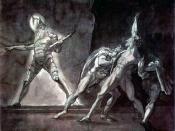In 1994 Nick Leeson, a trader at Barings Bank in London, generated a substantial amount of debt by investing in an unstable market. Attempting to extricate himself from the financial mess, and cover up the debts, he made more frenetic deals. By the time the bank realized, Leeson had created over a billion dollars worth of debt. Trying to escape from his problems, Leeson decided to run away with his wife; first to Borneo and then to Frankfurt where he was arrested and extradited to Singapore, the place where his investing activities transpired.
People create problems for themselves and, to avoid the responsibility or consequences of it, many are tempted to try to escape from the difficulty, just as Nick Leeson tried to do. To escape from his predicament, Leeson physically ran away, but it is possible to escape from your problems in a variety of ways; people sometimes have an addiction to escape from their difficulties like alcoholism or drugs, or they try not to deal with it and read to escape to an imaginary world: endless ways exist.
However, just as in the case with Nick Leeson, all of these escapes offer only temporary solutions and eventually end up in a worse predicament. Even characters in great literary pieces try to escape somehow when forced to confront their problems. William Shakespeare's Hamlet and E.B White's Once More to the Lake show that when we are in a dilemma, we retreat in one way or another to escape from our problems, but always to no avail.
The play Hamlet, about a young prince, Hamlet, intent on avenging his father's death, clearly shows how Hamlet escapes from reality by relishing his own misery and living in the past;
Why, what an ass am I! This is most brave,


